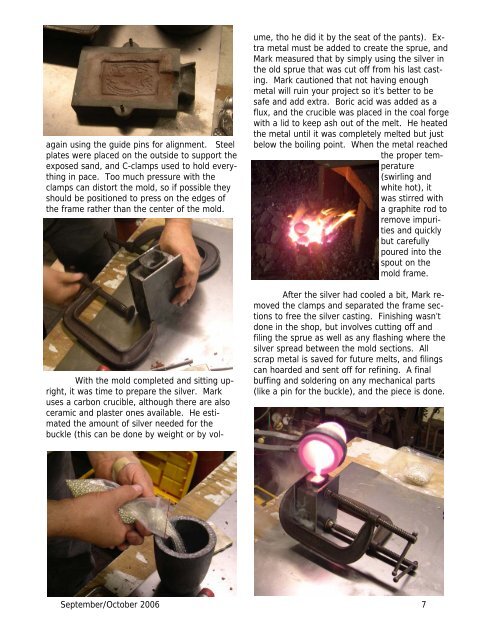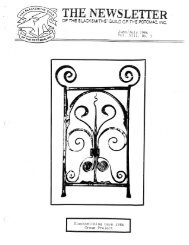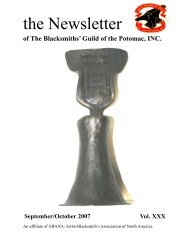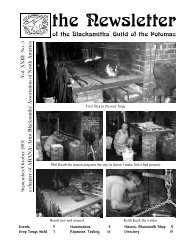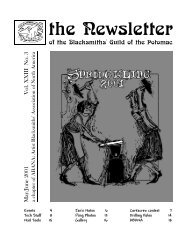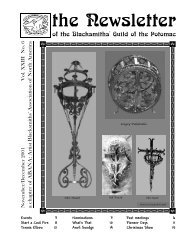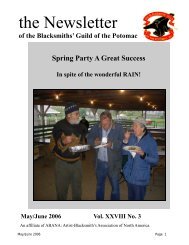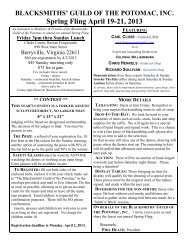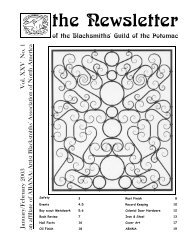Sept Oct 2006.pub - Blacksmiths' Guild of the Potomac
Sept Oct 2006.pub - Blacksmiths' Guild of the Potomac
Sept Oct 2006.pub - Blacksmiths' Guild of the Potomac
Create successful ePaper yourself
Turn your PDF publications into a flip-book with our unique Google optimized e-Paper software.
again using <strong>the</strong> guide pins for alignment. Steelplates were placed on <strong>the</strong> outside to support <strong>the</strong>exposed sand, and C-clamps used to hold everythingin pace. Too much pressure with <strong>the</strong>clamps can distort <strong>the</strong> mold, so if possible <strong>the</strong>yshould be positioned to press on <strong>the</strong> edges <strong>of</strong><strong>the</strong> frame ra<strong>the</strong>r than <strong>the</strong> center <strong>of</strong> <strong>the</strong> mold.With <strong>the</strong> mold completed and sitting upright,it was time to prepare <strong>the</strong> silver. Markuses a carbon crucible, although <strong>the</strong>re are alsoceramic and plaster ones available. He estimated<strong>the</strong> amount <strong>of</strong> silver needed for <strong>the</strong>buckle (this can be done by weight or by volume,tho he did it by <strong>the</strong> seat <strong>of</strong> <strong>the</strong> pants). Extrametal must be added to create <strong>the</strong> sprue, andMark measured that by simply using <strong>the</strong> silver in<strong>the</strong> old sprue that was cut <strong>of</strong>f from his last casting.Mark cautioned that not having enoughmetal will ruin your project so it’s better to besafe and add extra. Boric acid was added as aflux, and <strong>the</strong> crucible was placed in <strong>the</strong> coal forgewith a lid to keep ash out <strong>of</strong> <strong>the</strong> melt. He heated<strong>the</strong> metal until it was completely melted but justbelow <strong>the</strong> boiling point. When <strong>the</strong> metal reached<strong>the</strong> proper temperature(swirling andwhite hot), itwas stirred witha graphite rod toremove impuritiesand quicklybut carefullypoured into <strong>the</strong>spout on <strong>the</strong>mold frame.After <strong>the</strong> silver had cooled a bit, Mark removed<strong>the</strong> clamps and separated <strong>the</strong> frame sectionsto free <strong>the</strong> silver casting. Finishing wasn’tdone in <strong>the</strong> shop, but involves cutting <strong>of</strong>f andfiling <strong>the</strong> sprue as well as any flashing where <strong>the</strong>silver spread between <strong>the</strong> mold sections. Allscrap metal is saved for future melts, and filingscan hoarded and sent <strong>of</strong>f for refining. A finalbuffing and soldering on any mechanical parts(like a pin for <strong>the</strong> buckle), and <strong>the</strong> piece is done.<strong>Sept</strong>ember/<strong>Oct</strong>ober 2006 7


